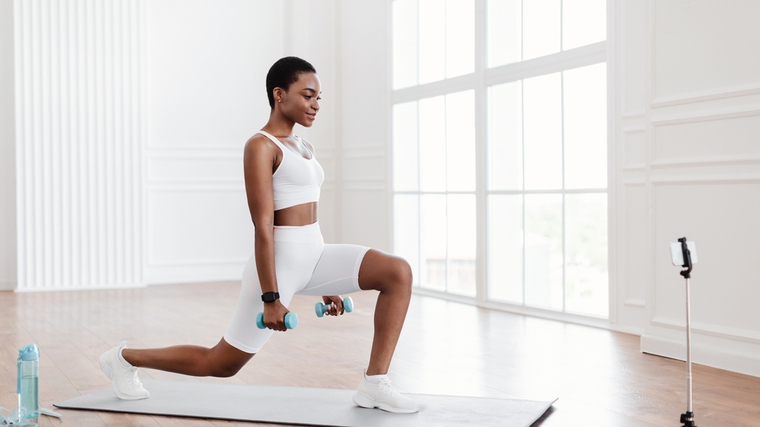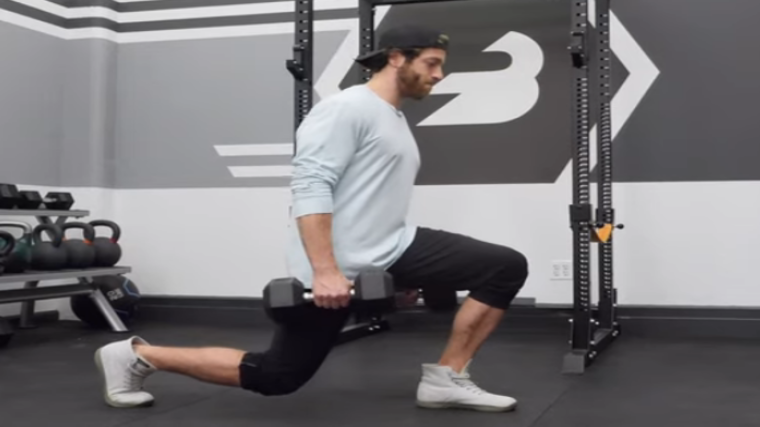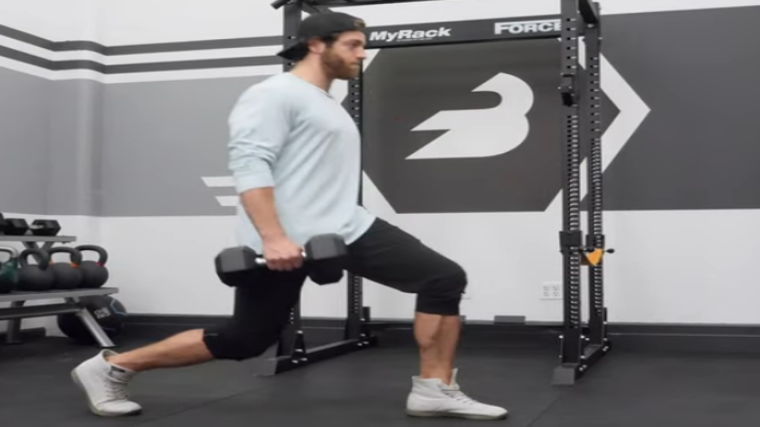When looking to build bigger, stronger legs, movements like squats and deadlifts are often great places to start. But if you only work these big movements, you might be leaving gains on the table. Without high quality leg accessory exercies, you may be missing out on added muscle growth, knee and hip stability improvements, and minimizing strength and muscle imbalances.

The dumbbell walking lunge is a lower body unilateral exercise that can be used to increase quadriceps, hamstrings, and glute strength and hypertrophy. It can also help improve balance and coordination, and pattern joint movements applicable to everyday locomotion (running, sprinting, walking, and climbing steps). Whether you want to gain leg muscle, strength, increase athletic performance, or improve your injury prevention, the dumbbell lunge is a must do.
- How to Do the Dumbbell Lunge
- Benefits of the Dumbbell Lunge
- Muscles Worked by the Dumbbell Lunge
- Who Should Do the Dumbbell Lunge
- Dumbbell Lunge Sets and Reps
- Dumbbell Lunge Variations
- Dumbbell Lunge Alternatives
- Frequently Asked Questions
How to Do the Dumbbell Lunge
The dumbbell lunge is a foundational unilateral exercise that trains the lower body. You can perform this move stationary or while walking. For the sake of this guide, we will discuss the more dynamic lunge variation — the dumbbell walking lunge.
Below is a step-by-step guide on how to perform the dumbbell walking lunge. You can do this with the dumbbells by your sides or held in the front rack position.
Step 1 — Grab the Dumbbells and Stand Tall
Start by picking up dumbbells, one in each hand. Hold them by your sides OR on your shoulders in the front rack position. Squeeze your core and stand tall.

Coach’s Tip: If you hold the dumbbells at the shoulders, it may be more of a challenge with heavier loads. If you want to really lift heavy and be less limited by the weight position, hold them by your sides.
Step 2 — Step One Leg In Front of You and Lunge
Step forward with your chest tall. Bring your front thigh near to parallel with the ground. Your back knee should go to the floor. Do not crash your knee into the floor — gently touch the ground only for a moment.

Coach’s Tip: Keep the weights from swinging forwards as you lunge.
Step 3 — Stand Up Through the Front Leg
Once your knee grazes the ground, drive through the lead leg. Stand up. Make sure to stand tall before going into the next rep. Step your other leg forward and repeat.

Coach’s Tip: It is critical that your front heel does not lift as you lunge forward. This will keep your hips steady and help prevent you from losing balance.
Benefits of the Dumbbell Lunge
These unilateral lower leg builders can be a valuable movement in your lower body training for muscle growth, leg strength, and injury prevention.
Combat Strength and Muscle Asymmetries
Unilateral training is very important for even lower leg development and training. Increases in unilateral muscular development, strength, and coordination can increase bilateral performance, muscular activation, and growth. When you’re focusing on one leg at a time, you’ll be able to reduce strength and muscle asymmetries that can lead to plateaus or potential injury.
Increase Hypertrophy
Because it targets your lower body with potentially high volume, the dumbbell lunge is a great exercise to add quality muscular hypertrophy to the lower body. Altering the variations, tempos, and training schemes (reps and sets) can further help boost muscle growth from lunges.
Increase Knee and Hip Stability to Boost Injury Prevention
Unilateral movement asymmetries and muscular imbalances can often cause injuries. This can happen due to poor movement patterning and compensations, which can develop when you only perform bilateral exercises. Moves like dumbbell lunges can work to increase unilateral coordination, balance, and performance — and therefore help prevent injury.
Improve Sports Performance
Whether you are a runner, sprinter, or multi-sport athlete, unilateral and multi-directional lunging (side, reverse, walking, diagonal, etc.) are key for improving joint mobility, coordination, and movement development. You’ll develop a more intuitive sense of where your body is and how it moves in space that can translate nicely into whatever sport you play.
Muscles Worked by the Dumbbell Lunge
The dumbbell lunge is a multi-joint exercise that builds the quadriceps, glutes, and hamstrings. Since the knees and hips flex and extend during the movement, you will train those muscle groups.
Glutes
Your glutes work overtime in the lunge to stabilize your knee during the movement. They will also help to extend the hip as you stand up. Like squats, the deeper the lunge, the more involved your glutes are.
Quadriceps
The quadriceps work to extend the knee. As you lunge, your knee bends and goes into flexion. This places muscular tension on the quadriceps. Similar to squats, if you want to target the quadriceps more — or get a more effective muscle stimulus — make sure to go all the way down in the lunge. This can help build stronger, healthier knees in the process.
Hamstrings
The hamstrings are active during the lunge. However, in most instances, they assist the glutes and quadriceps by helping extend the hips and stabilize the knees. If you take longer strides and go deep in the lunge, you will activate your hamstrings more.
Who Should Do the Dumbbell Lunge
Dumbbell lunges are a great way to build stronger, more muscular legs for any level or goal. Lunges are a unilateral exercise that can help address muscle imbalances between your legs. They help increase overall leg strength to aid in sports performance, life, and movement.
Strength and Functional Fitness Athletes
The dumbbell lunge is a great accessory exercise for all strength and functional fitness athletes. It helps improve muscle and strength imbalances, which is great for muscle symmetry. Strength imbalances, when unaddressed, can also become a limiting factor — and potential injury risk — as you lift heavier weights under loaded barbells.
The dumbbell lunge also allows you to train for more muscle growth and leg strength. You can add quality volume to a barbell-focused routine without such heavy weights. With lunges — even heavy lunges — you won’t subject your body to so much spinal loading. So, you can get in a tough leg workout with much less weight, and therefore less recovery demands.
Regular Gymgoers
Even if you’re not training for a competition, the lunge is a tremendously functional movement that the average gymgoer can benefit from tremendously. The ability to lunge without pain is key for so many activities of daily life. If you are unable to lunge or have weakness in your legs, you may be more susceptible to knee pain, loss of mobility and functionality, and over time could struggle to move around with ease.
Dumbbell Lunge Sets and Reps
If you are looking to add leg mass and strength, adding the dumbbell lunge into your current lower body routine could result in serious muscle growth and improved bilateral lifts like squats. Lunges also offer you the opportunity to build both mobility and stability while helping prevent injury.
To Build Muscle Mass
Building bigger legs, specifically the glutes and hamstrings, is one main goal of performing the lunge. When trained in moderate rep ranges, or even higher rep ranges, you can build muscle mass, increase muscle endurance, and help improve joint mobility and stability.
[RELATED: Best Mobility Exercises]
Start by programming three to five sets of 10 to 15 repetitions with moderate to heavy loads OR two to four sets of 15 to 25 repetitions with moderate loads to near failure. Keep rest periods between 45 and 90 seconds.
You can build muscle with both higher and moderate rep ranges. The key thing is to train to near failure or failure, especially if the weights are lighter.
To Increase Strength
The dumbbell lunge can be trained heavily to increase unilateral leg strength. For stronger lifters, carrying heavy dumbbells may become an issue, even with straps. In these cases, switching to barbell lunges may be better if holding the dumbbells becomes a limiting factor, rather than leg strength.
Start by programming three to five sets of five to 10 repetitions with heavy loading, resting as needed. You technically could perform three to five reps per leg with much heavier weights. However, if you’re choosing to proceed that way, make sure you adequately build up to this — and that you have enough space for recovery in your program.
Also, be sure to perform heavy lunges in an area where you are able to bail if needed. In other words, make sure you can safely drop the weights if you get stuck in the bottom of the lunge.
Dumbbell Lunge Variations
In some instances, you will want to add lunging variations to target different areas of the legs, address movement and balance asymmetries, or simply add variety to your workouts. Below are a list of a few of the most popular dumbbell lunge variations used to develop the lower body.
Reverse Lunge
The reverse lunge (also called the drop lunge) is a popular variation to target your hamstrings and glutes. This is especially true if you take a bigger step back. That’s because you’re forced to eccentrically contract your hamstrings and glutes to control the lowering phase and concentrically assist in the upwards phase.
This movement slightly differs from the forward lunge, as it disperses the load more intensely across the posterior chain.
Forward Lunge
The forward lunge is often performed with a small step forward. This eccentrically lowers your body downwards into the split via your quadriceps muscles, which must then concentrically contract to bring you upright.
The loading is slightly greater on the quadriceps than in the reverse variation. However, taking bigger steps will increase the involvement of your posterior chain.
Front-Foot Elevated Reverse Lunge
Like the reverse lunge, the front-foot elevated lunge also largely targets your hamstrings and glutes. However, because you’ll have your front foot on a box or bench, you’ll move through a larger range of motion with this variation.
This results in a more vertical back and torso angle. Because of this, you’ll be moving very similarly to the pattern of a back squat. This can further increase muscular hypertrophy and crossover into increased squat strength.
Dumbbell Lunge Alternatives
Sometimes, dumbbell lunges may not be accessible to you, whether because of space requirements, injury, or sheer preference. The dumbbell lunge alternatives below offer many of the same benefits as dumbbell lunges, but also allow you to individualize your unilateral lower body training to meet your current goals and needs.
Bulgarian Split Squat
The Bulgarian split squat is a close cousin of the dumbbell lunge. It trains many of the same muscles, with the added benefit of placing nearly all the loading onto one leg.
This exercise is a brutal unilateral lower body exercise that can produce massive quads and stronger glutes. This is done by placing your back leg on a bench, and placing all the loading on the lead leg.
Step Up
The step up is a unilateral exercise that can be done to target the quads and the glutes primarily. Unlike with the lunge, you can manipulate the height of the step to train partial and full ranges of knee flexion.
This is also less eccentrically demanding, which could be a good move for lifters who suffer from knee pain or want to focus on concentric strength.
Split Squat
The split squat is a stationary lunge alternative that has you maintain a wide split stance as you go up and down, allowing the knees to bend. Your legs will get a similar workout to lunging, but your feet won’t move position.
You can do this by starting in the wide split stance and dropping your back knee to the floor. You’ll place most of your weight on your front foot. This requires slightly less balance and coordination than a dumbbell lunge, and can be a good regression for those who may not be ready for dynamic lunges.
FAQs
You’re mostly convinced that incorporating dumbbell lunges into your routine, but you still have questions. That’s okay — here are your answers.
Are deep lunges bad for your knees?
In general, no. Many people can benefit from using less weight and going all the way down in their lunge to build healthier knees. In the beginning, you may need to use no weight or even have assistance. However, gaining strength in the deeper ranges of the lunge and squat can build stronger muscles, connective tissues, and increase muscle coordination.
Can you lift heavy weights when doing lunges?
Yes, you sure can. That said, it’s important that you are still able to perform them with control and not crash your knees into the floor. Skilled lifters can often be seen using pairs of 100 pound dumbbells for walking lunges, or more. Start light, work your way up, and you can often go as heavy as you would like — as long as you are able to train with good form and control, then recover adequately afterwards.
Final Word
The dumbbell lunge can help you build strong and muscular legs, increase squat strength, and help minimize injury. Like all unilateral exercises, you can train with relatively less loading than bilateral counterparts, but still stimulate massive amounts of muscle. Lunges, as well as the above variations and alternatives, should find their way into most good training programs.